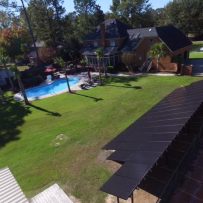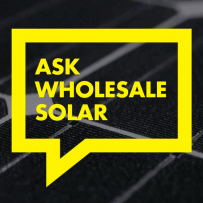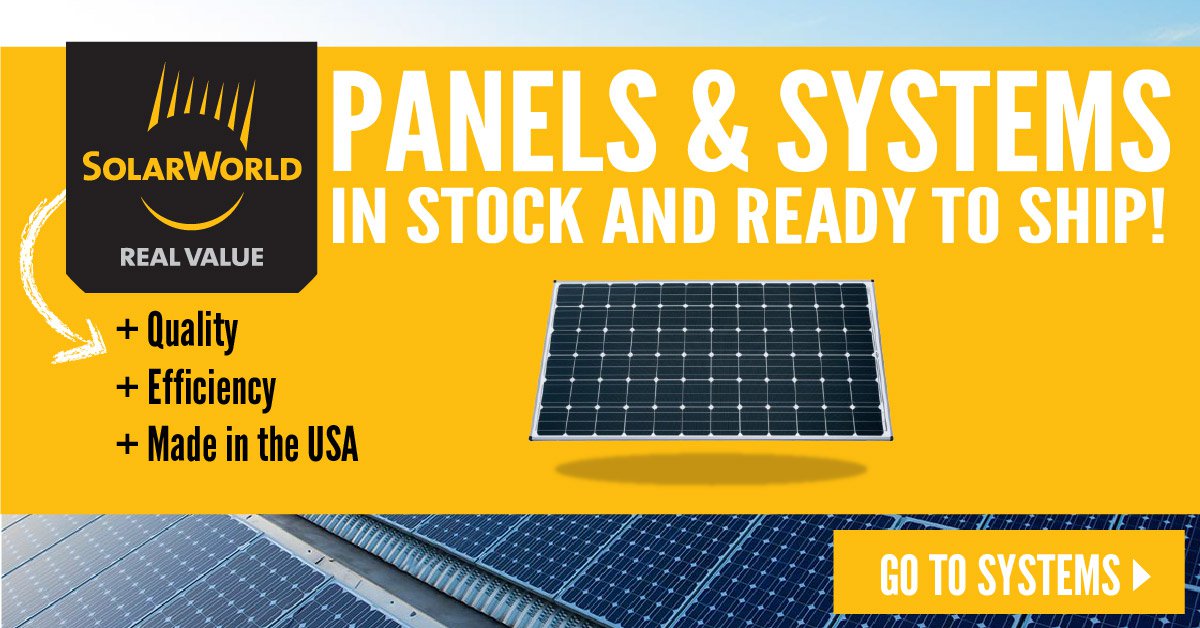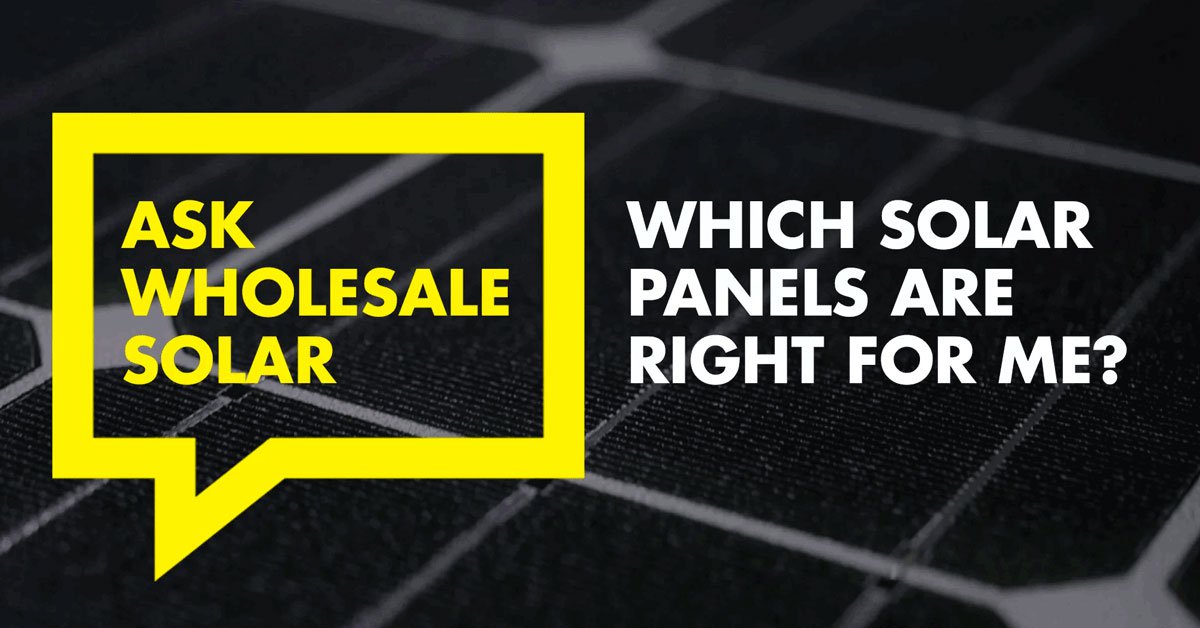Solar Panels - Choose from a variety of brands like Astronergy, Suniva, Solarland and SolarWorld
Packaged Systems - Complete solar power package solutions for offgrid, gridtie, backup power, boats, RVs, telecommunications and more!

Specials - Check out items currently on sale or items like refurbished inverters with special pricing.
Power Centers - Wholesale Solar offers prewired and tested inverter systems for offgrid and backup power applications.
Backup Power - Plug n Play systems provide emergency electrical power for your home or business when the grid goes down.
"Wholesale Solar is 100% employee owned. Each of us has a personal stake in providing outstanding service to our customers. We thrive on your success!" -Allie, Employee Owner
Welcome to Wholesale Solar
We are your source for discount prices on solar panels and renewable energy products for home power, back-up power, solar & wind power, off-grid & grid intertied residential, marine and RV power systems. Retail and wholesale pricing.
We design and sell solar panel systems for projects large and small, for homeowners and do-it-yourselfers, contractors, installers, electricians, and developers. Call one of our experienced solar design techs to talk about your project at 1-800-472-1142. If you have your most recent electric bill handy, we'll be able to get started with the design process right away.
Discount Pricing on Pallets of Solar Panels
| Model | Brand | Part # | Watts | Quantity Per Pallet | Total Pallet Watts | Price Per Watt | Price |
|---|---|---|---|---|---|---|---|
| Astronergy ASM6612P-315 Silver Poly Pallet (20) of Solar Panels | Astronergy Solar | 1977411 | 315 W | 20 | 6,300 W | $0.83 | $5,200.00
Qty
|
| Astronergy VIOLIN CHSM6610P-260 Silver Poly Pallet (25) of Solar Panels | Astronergy Solar | 1890031 | 260 W | 25 | 6,500 W | $0.79 | $5,125.00
Qty
|
| SolarWorld SW325 XL Silver Mono Pallet (29) of Solar Panels | SolarWorld | 1922326 | 325 W | 29 | 9,425 W | $0.92 | $8,700.00
Qty
|
| SolarWorld SW340 XL Silver Mono Pallet (29) of Solar Panels | SolarWorld | 1891995 | 340 W | 29 | 9,860 W | $1.03 | $10,150.00
Qty
|
| Suniva OPT285 Silver Mono Pallet (25) of Solar Panels | Suniva | 1894436 | 285 W | 25 | 7,125 W | $0.98 | $7,000.00
Qty
|
Discount Prices on Solar Panels
| Model | Brand | Part # | Watts | Minimum Quantity | Price Per Watt | Price |
|---|---|---|---|---|---|---|
| Astronergy VIOLIN CHSM6610P-260 Silver Poly Solar Panel | Astronergy Solar | 1970260 | 260 W | 1 | $0.87 | $225.00
Qty
|
| Astronergy ASM6612P-315 Silver Poly Solar Panel | Astronergy Solar | 1977410 | 315 W | 1 | $0.89 | $280.00
Qty
|
| SolarWorld SW285 Plus Black Mono Solar Panel | SolarWorld | 1922388 | 285 W | 1 | $1.09 | $310.00
Qty
|
| SolarWorld SW325 XL Silver Mono Solar Panel | SolarWorld | 1922325 | 325 W | 1 | $0.98 | $320.00
Qty
|
| SolarWorld SW340 XL Silver Mono Solar Panel | SolarWorld | 1922340 | 340 W | 1 | $1.09 | $370.00
Qty
|
| Suniva OPT285-60-4-100 Silver Mono Solar Panel | Suniva | 1524436 | 285 W | 1 | $1.05 | $300.00
Qty
|
| Topoint JTM190-72M Silver Mono Solar Panel | Topoint | 1530190 | 190 W | 1 | $0.84 | $160.00
Qty
|
Expandable Enphase Microinverter Starter Kits
Includes:
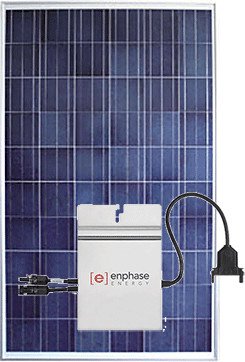
| Expandable Enphase Microinverter Starter Kits | Part No. | Array Size (STC) | Monthly Output (PTC) | Panels | Inverter | Price |
|---|---|---|---|---|---|---|
| 260 W Grid-Tied Solar System with 1x Astronergy 260W Panels | 1890800 | 260 W | 35 kWh | 1 Astronergy VIOLIN CHSM6610P-260 Silver Poly Solar Panel | 1 Enphase M250 With MC4 Micro Inverter |
$1,039.00
Qty
|
| 520 W Grid-Tied Solar System with 2x Astronergy 260W Panels | 1890805 | 520 W | 71 kWh | 2 Astronergy VIOLIN CHSM6610P-260 Silver Poly Solar Panel | 2 Enphase M250 With MC4 Micro Inverter |
$1,373.00
Qty
|
| 780 W Grid-Tied Solar System with 3x Astronergy 260W Panels | 1890810 | 780 W | 106 kWh | 3 Astronergy VIOLIN CHSM6610P-260 Silver Poly Solar Panel | 3 Enphase M250 With MC4 Micro Inverter |
$1,848.00
Qty
|
| 1 kW Grid-Tied Solar System with 4x Astronergy 260W Panels | 1890815 | 1.04 kW | 141 kWh | 4 Astronergy VIOLIN CHSM6610P-260 Silver Poly Solar Panel | 4 Enphase M250 With MC4 Micro Inverter |
$2,287.00
Qty
|
Enphase Microinverter Systems
Includes:
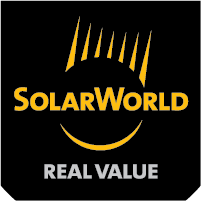
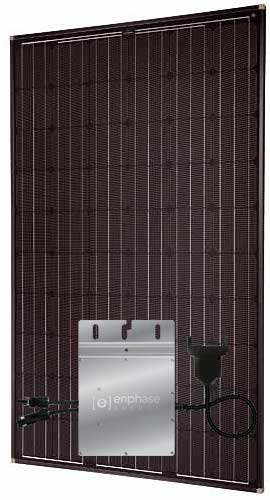
Equipped with OutBack Power's Radian inverters, these solar power grid-tie systems will power 120-volt and 240-volt circuits. Designed with true off-grid capability, you can charge your battery bank with solar panels or a gas generator. More versatile than the systems above, these systems also have a 'grid-assist mode' for folks mainly interested in being off the grid, but would like to have access to grid power.
Call a Wholesale Solar technician for help sizing these systems and choosing the correct battery bank size.
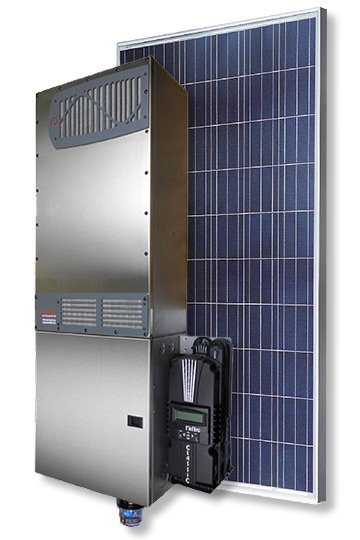
Grid-Tied Solar Systems with Outback Radian and Suniva 285 W Panels
What follows is basic history about solar panels and information to help you know what solar panels to buy.
Solar Panels: Harvesting the Energy from our Sun
Virtually unlimited power is available from our nearest star, the Sun. In just one hour, our
planet receives more energy from the sun than the entire world uses during an entire year.
Electricity-producing solar panels have only been around for the last 60 years, yet they have
completely transformed how we harness solar energy
In 1839, a nineteen year-old French physicist named Alexandre-Edmond Becquerel
discovered the operating principle of the solar cell, known as the photovoltaic effect. It wasn’t
until 1876 that this effect materialized into a viable method of producing electricity with the
work of William Grylls Adams. He discovered that by illuminating a junction between selenium and
platinum, a photovoltaic effect occurs; electricity could now be produced without moving
parts.
Revolutionary as they may have been, the selenium solar cells were not efficient enough to power
electrical equipment. That ability occurred in 1953 when a Bell Laboratories employee Gerald
Pearson had the bright idea of making a solar cell with silicon instead of selenium. The New
York Times heralded the discovery as “The beginning of a new era, leading eventually to
the realization of harnessing the almost limitless energy of the sun for the uses of
civilization”.
Just in time for the space race, the first solar panels made their debut in the satellite
industry. Vanguard I, the first solar-powered satellite celebrated its 53rd birthday this year,
setting mileage records and holding the title of being the oldest artificial satellite still in
orbit.
The first solar modules were only efficient enough for space applications, where the Sun’s
radiation is much stronger. Eventually satellite research paved the way for Earth-based
technology. The 1990’s were pivotal years for photovoltaic technology. Innovations in
solar cells allowed for greater efficiency while lowering the cost of production. Germany and
Japan led the way with long-term solar power incentive programs helping lower the cost to the
public, and spurring the growth of a robust Photovoltaic industry in both countries.
California Leads the Nation
In 2006, California made a major
long-term commitment to solar power by passing the California Solar Initiative, a ten-year
incentive program with the goal of installing 3,000 megawatts of solar panels on the equivalent
of one million rooftops. California leads the nation in solar panel installations, as it
currently has more photovoltaic systems installed than any other state. This incredible boom has
taken place mostly due to California’s Renewable Portfolio Standard, which requires that
20 percent of the state’s electricity come from renewable resources by 2010. In 2008 the
state decided that it was not moving fast enough in meeting these goals and enacted a feed-in
tariff, requiring utility companies to buy back excess power produced by homeowner’s and
private photovoltaic installations. In the same year, the state also raised the Renewable
Portfolio Standard to 33 percent by 2020, greatly helping spur growth in the renewable energy
industry.
How Solar Panels work
Photovoltaic solar modules are composed of multiple, interconnected solar cells,
which effectively trap photon energy between layers of silicon wafers. Negatively charged
electrons are then knocked loose from their atoms, allowing them to flow freely through the
semiconductors. Separate diodes, and P-N junctions prevent reverse currents and reduce loss of
power on partially shaded panels.
Since the flow of electrical current is going in one direction, like a battery, the electricity generated is called direct current (DC). Sunlight conversion rates are typically in the 5 to 18 percent range, with some laboratory experiments reaching efficiencies as high as 30 percent. Future possibilities include the development of multi-junction solar cells that are capable of harnessing a wider bandwidth of useable light. We are still considered to be in the “early” stages of solar cell technology.
Solar Panel Components
Photovoltaic solar panels are the main building block in a solar power system. Since each solar
module produces a limited amount of power, installations usually consist of multiple panels,
called an array. The array produces DC (direct current), which can be stored in batteries or
instantly converted into AC (alternating current) required by conventional appliances.
Equipment that converts the power from DC to AC is known as an solar inverter, and
they come in a few varieties, modified sine wave or pure sine wave. They are further classified
based on which type of system it is to be used in, whether it is off-grid or grid
interconnected. Recently the innovation of micro inverters has greatly
simplified installations, and makes it easy to add on panels to an installation. Each solar
module is paired with its own micro inverter, which then coverts the power directly at the
panel. For off grid installations the use of a charge controller is necessary to properly manage
the power harvest, charge the batteries, and prevent overcharging.
The greatest innovation in charge controllers would have to be the relatively new feature called
maximum power point tracking (MPPT). This innovative method of charging batteries constantly
monitors peak power voltage from the array and input voltage on the batteries adjusting amperage
to compensate for the fluctuations. This provides the most efficient means to manage the power
harvest. The function of MPPT charge controllers is analogous to the transmission of a car,
keeping your charging system in the “right gear”. Other components of the solar
system would include the wiring and mounting hardware, while some installations use a tracker
that changes its tilt angle and direction throughout the day.
Types of Solar Panels
Solar panels are classified into three classes: mono-crystalline
(single crystal), poly-crystalline
(multiple crystals), or amorphous silicon. Mono-crystalline is indicative of the
continuous and unbroken sample of silicon in which the cell is manufactured from. This method
uses very pure silicon grown in a complex growth process, and then sliced into wafers that
compose the individual cells. This was the first method used to manufacture solar cells, and are
still highly regarded for their efficiency ratios.
Poly-crystalline panels are composed of many crystallites of varying size and
orientation. These multi-crystalline panels are generally less expensive and slightly less
efficient than mono-crystalline modules, yet lately the difference in efficiency is very small.
Like their mono-crystalline counterpart, the cells are also cut into wafers that make up the
individual cells of a solar panel.
Amorphous solar panels use the non-crystalline, allotropic form of silicon, in which a thin
layer of this silicon substrate is applied to the back of a plate of glass. These panels are
much cheaper and less energy efficient, yet they are more versatile in how they can be used. For
example, amorphous solar panels can be manufactured into long sheets of roofing material. Thin
Film solar panels also fall into the amorphous category. This type of cells can be mounted on a
flexible backing, making them more suited for mobile applications.
Each of the solar panel types is estimated to last at least twenty-five years. Instead of
stopping production completely, electricity production will decline a little, gradually, over
decades. The longevity of a solar panel refers to the number of years before the unit starts
producing only 80 percent of its original power rating. The industry standard for warranties is
20 to 25 years, although it is not uncommon for panels to produce adequate power for over 30
years.
Off Grid versus Grid tied
Solar panels are used extensively in rural areas, where access to the grid is non-existent or
inaccessible. These installations are called off grid (or independent, stand-alone) solar power
systems, and require the use of batteries to store the energy for use at night or on long
stretches of overcast weather. The energy stored in the batteries leaves the batteries as DC
electricity which can power DC appliances (as in RV’s) or be converted to alternating
current (AC) for use with conventional appliances. Much like running your own mini utility
company, this method gives you full independence from the national grid.
You can eliminate the cost of batteries by going with a system that connects right
into your home’s main junction box and use the grid as your power source at night or on
long stretches of inclement weather. These installations are known as grid-tied or
grid-interconnected systems. This version of solar system enables you to sell any excess power
you produce back to the utility companies who have chosen to support “net metering”.
Once you are signed up on a net metering program, your utility company will have a smart meter
installed known as a Time of Use Meter, which will actually run backwards when you are producing
excess power. It is wise to keep in mind that Grid tied systems without a battery backup, are
only functional when the grid is operational. Due to anti-islanding features on grid tied
inverters, which protect utility workers from working on a live line, grid-tied systems without
a battery back up will not continue to produce power during a power outage regardless of whether
you have sunshine or not.
Since solar panels produce DC, or direct current, they must be coupled with a solar inverter to
convert the energy from DC to AC, or alternating current. In a grid tied system this can be done
by a large central inverter, or each solar panel can be outfitted with its own micro inverter.
Once the power is converted to alternating current and its phase is synchronized with that of
the grid, it is then tied in to your main junction box, which is ultimately interconnected to
the national grid.





